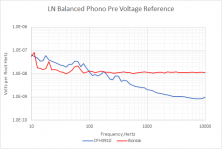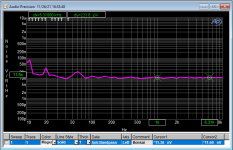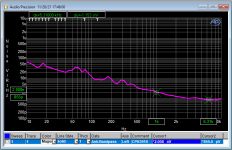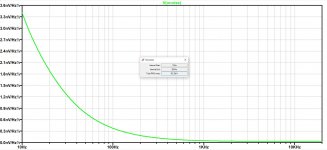As I mentioned several days ago, for Vref, I thought a simple JFET current source would be quieter and easier to implement than the LM4562/ZTX851. (The Idss of the CPH3910 is 33mA in this trial, and it is quieter where ears count.) I think the CPH3910 is about $0.48.
I don't understand what is Vref (doesn't seem like related to #176) and in general I don't understand how you are suggesting to replace a voltage source (Vref) with a current source (JFET).
Also don't understand what has the Groner amplifier to do with this topic (in general and in particular).
A schematic would go a long way.
Also don't understand what has the Groner amplifier to do with this topic (in general and in particular).
A schematic would go a long way.
Sam's amplifier is for measuring noise, and the couple I have built check in at 500pV/RtHz or better which is more than adequate for the job. So I measured the noise injected which would be present at the ZTX851 collectors. His amplifier is not quite as fussy as others and is very resilient.
As the load impedance is static, how much does it matter?
When a final design is settled upon will see if the two make an audible or even measurable difference. I am struggling to determine why the suggestion of a simple remedy would be annoying.
As the load impedance is static, how much does it matter?
When a final design is settled upon will see if the two make an audible or even measurable difference. I am struggling to determine why the suggestion of a simple remedy would be annoying.
I am struggling to determine why the suggestion of a simple remedy would be annoying.
I am pretty sure the annoyance has in part to do with the lack of clarity of your suggestion(s); I am myself mildly annoyed that after 3 posts exchange I still don’t understand your suggestion, what/where/how did you measure the noise, what are you comparing, etc…
I’ll let others to figure out this puzzle, obviously I’m too dense for it.
Jack, Can you sketch it out?
The noise floor is currently simming at a shade under 300 pV/rt Hz as measured at Vout. The transistor bases are decoupled to ground with 1000uF caps fed through 2.2k resistors and the 10V rail via 10 ohms and 1000 uF so both these networks must be included in the noise analysis. On the X-Altra, the PSU noise was about 7nV 20-20 and 300 pV/rt Hz spot noise at 1 k. Obviously, it increases at LF due to 1/f - so similar to the current approach.
The LM4562 + ZTX851 form a 35 mA 10 V regulator that feed the collectors. This voltage is also divided down to form the base reference at 2.1 V.
The noise floor is currently simming at a shade under 300 pV/rt Hz as measured at Vout. The transistor bases are decoupled to ground with 1000uF caps fed through 2.2k resistors and the 10V rail via 10 ohms and 1000 uF so both these networks must be included in the noise analysis. On the X-Altra, the PSU noise was about 7nV 20-20 and 300 pV/rt Hz spot noise at 1 k. Obviously, it increases at LF due to 1/f - so similar to the current approach.
The LM4562 + ZTX851 form a 35 mA 10 V regulator that feed the collectors. This voltage is also divided down to form the base reference at 2.1 V.
Last edited:
Since it concerns a diff topology, even with 1% collector resistors, PSRR is still 40dB. so I don't see the problem with the few nV/rtHz noise on Vref
Replacing Vref with a current source is a mysterious proposal.
Hans
Replacing Vref with a current source is a mysterious proposal.
Hans
I am with Jack on this one.
When I need to make a low noise Vref, I use LEDs feed via JFET CSS, and then RC low pass (1k, 1mF) taken off the LEDs. 10V requires 6 LEDs (well, Christmas is coming!) and here I might just use a resistor, as Jack did.
I would check PSRR before making that decision.
When I need to make a low noise Vref, I use LEDs feed via JFET CSS, and then RC low pass (1k, 1mF) taken off the LEDs. 10V requires 6 LEDs (well, Christmas is coming!) and here I might just use a resistor, as Jack did.
I would check PSRR before making that decision.
The TranBal PSU is about 45pV/rt Hz, 12.38 nV over 20-20kHz and the PSRR ~80 dB/decade from 10 Hz to 1kHz. The PSRR is > 120 dB from 4kHz to 80 kHz after which it rises and at 1MHz its still > 80 dB.
You have to include the 1000uF output cap - that's the reason for the compensation components (which may have to be tweaked once on the board). The X-Altra PSU does not use the series pass transistor and the base stopper, and the 10 ohm output resistor was 47 ohms (current draw was 3.5mA per rail, so about 10% of this design). The total integrated noise on that PSU is 7nV 20-20kHz.
You have to include the 1000uF output cap - that's the reason for the compensation components (which may have to be tweaked once on the board). The X-Altra PSU does not use the series pass transistor and the base stopper, and the 10 ohm output resistor was 47 ohms (current draw was 3.5mA per rail, so about 10% of this design). The total integrated noise on that PSU is 7nV 20-20kHz.
Attachments
Last edited:
Output 2 is quieter (simpler too) and yields the same Vref:
Output impedance of the bipolar voltage source is virtually zero, output impedance of your JFET alternative is 300ohm. You think this is irrelevant here? What about the load regulation?
It would also be interesting to find out the potential at the junction point of two fighting current sources (your JFET current source and the bipolar collectors).
Unless I'm again missing something... It is possible I am today as dense as yesterday, I don't understand Bonsai's comment as well. Who's TransBal, what is the relevance, etc...
Last edited:
TranBal = ‘transimpedance balanced’ head amp Syn08. No significance - it’s just what this thing is being called.
BTW the PSSR is not 80 dB/decade but ~40 dB/decade from 1Hz to 1kHz - my error.
I just redid the integrated noise over a more conventional 20-20kHz and not 10-20kHz as above and its 9.5nV
BTW the PSSR is not 80 dB/decade but ~40 dB/decade from 1Hz to 1kHz - my error.
I just redid the integrated noise over a more conventional 20-20kHz and not 10-20kHz as above and its 9.5nV
Last edited:
Ok, do you understand what is Jack suggesting? Replacing the TranBal PSU with a JFET current source? Am I high, or what?
Replacing a reference voltage with a low noise current source feeding a resistor is possible, and in fact used even in ICs, the LT3045 is built on this principle. But an entire power supply, don't think so.
Replacing a reference voltage with a low noise current source feeding a resistor is possible, and in fact used even in ICs, the LT3045 is built on this principle. But an entire power supply, don't think so.
Last edited:
Output 2 is quieter (simpler too) and yields the same Vref:
Dream on, it doesn't in real life.
Vref will be all over the place and by no way being constant with a low output Z.
BTW: you made my day.
I am with Jack on this one.
When I need to make a low noise Vref, I use LEDs feed via JFET CSS, and then RC low pass (1k, 1mF) taken off the LEDs. 10V requires 6 LEDs (well, Christmas is coming!) and here I might just use a resistor, as Jack did.
I would check PSRR before making that decision.
What you are posting is a different thing, I would actually put the LED string (fed with a CCS) and connec it to the Base of a BJT and take the Vref from the Emitter of that BJT.
That will give you a low noise Vref with a low output Z.
Ok, do you understand what is Jack suggesting? Replacing the TranBal PSU with a JFET current source? Am I high, or what?
Replacing a reference voltage with a low noise current source feeding a resistor is possible, and in fact used even in ICs, the LT3045 is built on this principle. But an entire power supply, don't think so.
What Jack is proposing wont work in real life.
It would also be interesting to find out the potential at the junction point of two fighting current sources (your JFET current source and the bipolar collectors).
Yes.
Ok, do you understand what is Jack suggesting? Replacing the TranBal PSU with a JFET current source? Am I high, or what?
Replacing a reference voltage with a low noise current source feeding a resistor is possible, and in fact used even in ICs, the LT3045 is built on this principle. But an entire power supply, don't think so.
Yes of course I understand but there’s no problem from my side discussing these things or putting ideas up, but given the sim results and the other advantages, I’m sticking with the voltage reg approach.
🙂
As a general comment (not related to Jack’s input), I am not a fan of super regs. I prefer jellybean 3 terminal regs (+-15 V for standard analog work ie 7815) and then if I really need something quiet, as we do here, and as in the X-Altra MC/MM, I use a local high performance reg. Typically you only need a few 10’s of mA and you can make it ultra low noise. With super regs, by the time you are 6” away from the reg and there’s half a dozen circuits pulling and pushing the rails, you are unlikely to have what you think you do at the super reg output terminals. And, leveraging modern opamp PSRR can give superb results as a linear reg eg the LM4562 and its cousins offer 120 dB at LF, and the OPA1611 is no slouch either.
In the spreadsheet I posted in #219, to calculate the noise I used a (simple version)*(correction factor) to get the correct noise RTI.
The simple version is 2*Rbb+2*1/2Gm+RCart.
However, the two 100R base resistances, the 294R//625R collector resistances and even the Ro's from the ZTX81 transistors are all contributing to the final noise.
That's why a model was made with an op-amp that conformed in gain and in noise to the complete TranBal model with ZTX81 transistors.
To make the gain equal, a 3.555R input resistance and a 88K Ro were needed to get the gain right for all different Cart resistances.
The 3.555R represents the input resistance being ca. 2*1/Gm at Ic=15mA.
Next step was to make the noise equal between the two models.
For this a 1.218R resistor had to be inserted.
The resistance of both together 3.555+1.218 = 4.773 is supposed to be 2*Rbb+2*1/2Gm.
Since 2*1/Gm was already found to be 3.555R, this leaves 2.9955R for 2*Rbb or 1.5R for one ZTX81, well conforming to AoE.
Now comparing the correct model versus the simple model, both shown in the middle of the image below, a plot can be made what deviation the "real" model has versus the simple model.
While this is almost a straight line I could use the correction factor (1+Rcart*17/5000) without further having to make complex calculations.
Hans
The simple version is 2*Rbb+2*1/2Gm+RCart.
However, the two 100R base resistances, the 294R//625R collector resistances and even the Ro's from the ZTX81 transistors are all contributing to the final noise.
That's why a model was made with an op-amp that conformed in gain and in noise to the complete TranBal model with ZTX81 transistors.
To make the gain equal, a 3.555R input resistance and a 88K Ro were needed to get the gain right for all different Cart resistances.
The 3.555R represents the input resistance being ca. 2*1/Gm at Ic=15mA.
Next step was to make the noise equal between the two models.
For this a 1.218R resistor had to be inserted.
The resistance of both together 3.555+1.218 = 4.773 is supposed to be 2*Rbb+2*1/2Gm.
Since 2*1/Gm was already found to be 3.555R, this leaves 2.9955R for 2*Rbb or 1.5R for one ZTX81, well conforming to AoE.
Now comparing the correct model versus the simple model, both shown in the middle of the image below, a plot can be made what deviation the "real" model has versus the simple model.
While this is almost a straight line I could use the correction factor (1+Rcart*17/5000) without further having to make complex calculations.
Hans
Attachments
Bonsai,
I have reworked your spreadsheet in a model that conforms to the simulation within less than 2%.
Hope you can use this.
Hans
.
Thanks Hans - I’ll take a look later tonight.
- Home
- Source & Line
- Analogue Source
- Low noise Balanced MC Pre





